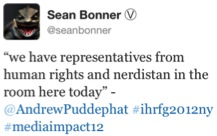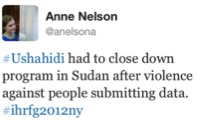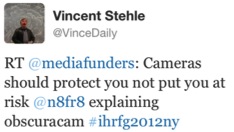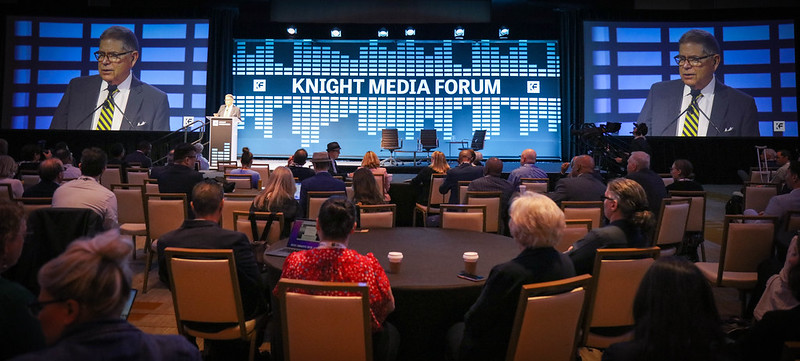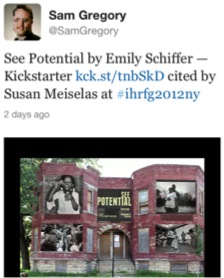
Human rights funders consider mobile media projects
Funders working to safeguard human rights have a wealth of opportunity in new mobile media tools. They got a glimpse of several of them recently in New York at the Paley Center during the annual meeting of the International Human Rights Funders Group.
Andrew Puddephatt, of Global Partners & Associates set the stage for why the digital age has made mobile media integral – both through opportunities and risks – to the human rights field.
Three hands-on demonstrations provided participants with an opportunity to see how mobile technology is currently being used to advance accountability and advocacy for human rights:
- Yvonne MacPherson from BBC Media Action brought hand-held card sets that interact with mobile phones to allow health workers to better communicate with individuals in their communities. Using pictures on the cards and recorded voice messages by a doctor on the phone – these tools help the health workers explain situations to the people they are trying to help.
- Rob Baker from Ushahidi showed the group its water mapping tool and explored the ways this platform could be used in different contexts by human rights funders and grantees.
- Sean Bonner from Safecast put Geiger counters, that measure radiation levels, in the hands of participants and explained why the tool worked to map radiation safe – and unsafe zones – in Japan. He talked about the implications and opportunities of using these types of initiatives in pre- and post-disaster zones.
Most worrisome for human rights advocates was a presentation led by Danny O’Brien from Committee to Protect Journalists with Eva Galperin at Electronic Frontier Foundation. They talked about the dangers of mobile media and what they mean for human rights advocates and the foundations supporting those individuals. Concerns include tracking capabilities of mobile phones that can give away a dissident’s location, and technologies that look like safeguarding tools but are applications that keep tabs on you! This part of the day was accompanied by a demo from Josh King at New America Foundation as well as Nathan Freitas from the Guardian Project with tools to help people and their information stay safe. Freitas provided demonstrations of Obscuracam – a tool to blur faces from video; the Tor Project – a way to keep personal IP addresses safe; as well as Informacam – a way of adding identifying information to pictures so that location and other details can be verified afterwards.
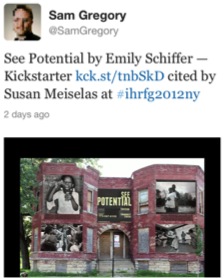
Anne Nelson, lecturer at Columbia University and leading scholar on international affairs and human rights, rounded out the conversations with examples for how to create compelling content. She also explored how human rights funders and their grantees might tell their stories with more impact. Photographer Susan Meiselas showed ways that pictures could demonstrate opportunity by showing physical places in ways that they could be. Sam Gregory of Witness gave insight on why video cantravel further than other mediums and what makes some videos more sharable than others. David Wertime, founder of Tea Leaf Nation, gave information about how people in China use Weibo to share information through a social network and what it means for human rights stories.
There were some key takeaways – ones that are similar to those from Journalism and Media Grant Making, a booklet created with community foundations in mind. For those interested, here are the highlights:
- Many of these mobile media projects can build on work already being done; such as adding mapping capabilities to a health or security project and to better tell the story on the ground;
- The digital age means that mobile projects can reach new audiences in different ways and mobile is part of the new human rights landscape;
- Mobile projects do not have to cost a lot;
- Other human rights and media funders may be interested in collaborating.
There’s an appetite to grow funder expertise in this space – so if you missed this meeting there are likely to be other opportunities.
By Amy Starlight Lawrence, project specialist at Knight Foundation, who was on the planning committee for the gathering. It was organized in collaboration with Grantmakers in Film + Electronic Media, led by Vince Stehle, which recently announced it will soon change its name to Media Impact Funders. Azeen Salimi helped organize the event, along with Zara Bohan, Sarah Armour-Jones and Anne Nelson.
Recent Content
-
Journalismarticle ·
-
Journalismarticle ·
-
Journalismarticle ·
